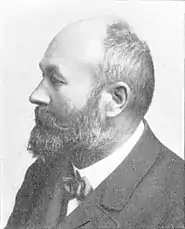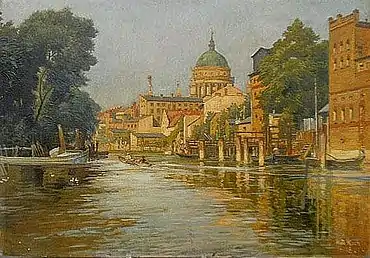Max Friedrich Koch
Max Friedrich Koch (24 November 1859, Berlin - 18 February 1930, Potsdam) was a German landscape and decorative painter.


Biography
He came from a family of artists. His father, Carl, and older brother Georg, were both painters. The three of them often worked together on large commissions and occasionally collaborated with the maritime artist, Hans Bohrdt. His younger brother, Friedrich, was a composer and music teacher.
He attended the Teaching Istitute of the Kunstgewerbemuseum Berlin, where he was a student of Eduard Schaller and Moritz Meurer (1839-1916). From 1876 to 1877, he undertook a study trip to Italy, with the help of a scholarship, and completed his studies upon returning to Berlin. Beginning in 1879, he worked with Friedrich von Thiersch, decorating the Alte Oper in Frankfurt am Main. The year 1881 found him in Paris, at the École Nationale Supérieure des Beaux-Arts, working with Pierre-Victor Galland.
In 1883, he returned to Berlin and took Meurer's place at the Teaching Institute. He would hold that position until 1894, when he was replaced by Max Seliger, then again from 1901 to 1924. During this time, he became known for his work on several panoramas. The first was in 1886, together with Alexander Kips, for the Jubilee Exhibition of the Prussian Academy of Arts, depicting the Temple of Zeus, in honor of the recent discovery of the Pergamon Altar, which was being brought to Berlin and reassembled. This was replaced in 1888, with a panorama by his brother, Georg, depicting the Great Fire of Rome. In 1891 this was, in turn, replaced by a collaboration between all three Kochs and Bohrdt, showing Kaiser Wilhelm II, on his way to visit the Bosporus Germans.
He also decorated numerous public and private buildings with monumental historical scenes, which were very popular during the Imperial period. This included areas in the Prussian House of Lords, the Prussian House of Representatives, and the Berlin-Brandenburg Academy of Sciences and Humanities, as well as in the Wertheim and Tietz department stores. Outside of Berlin, the Lübecker Rathaus is a notable example.
In 1907, he served as an expert witness in a case against the magazine Die Schönheit, which was accused of disseminating "lewd" drawings.
Sources
- "Koch, Max Friedrich". In: Hans Vollmer (Ed.): Allgemeines Lexikon der Bildenden Künstler von der Antike bis zur Gegenwart, Vol.21: Knip–Krüger. E. A. Seemann, Leipzig 1927, pps. 90–91.
- "Max Koch". In: Hans Vollmer (Ed.): Allgemeines Lexikon der bildenden Künstler des XX. Jahrhunderts. Vol.3: K–P. E. A. Seemann, Leipzig 1956, pg.75.
- Biography, paintings and criticism @ the Max Friedrich Koch Blogspot
External links
| Wikimedia Commons has media related to Max Friedrich Koch. |
- More works by Koch @ ArtNet
- Works by or about Max Friedrich Koch in libraries (WorldCat catalog)